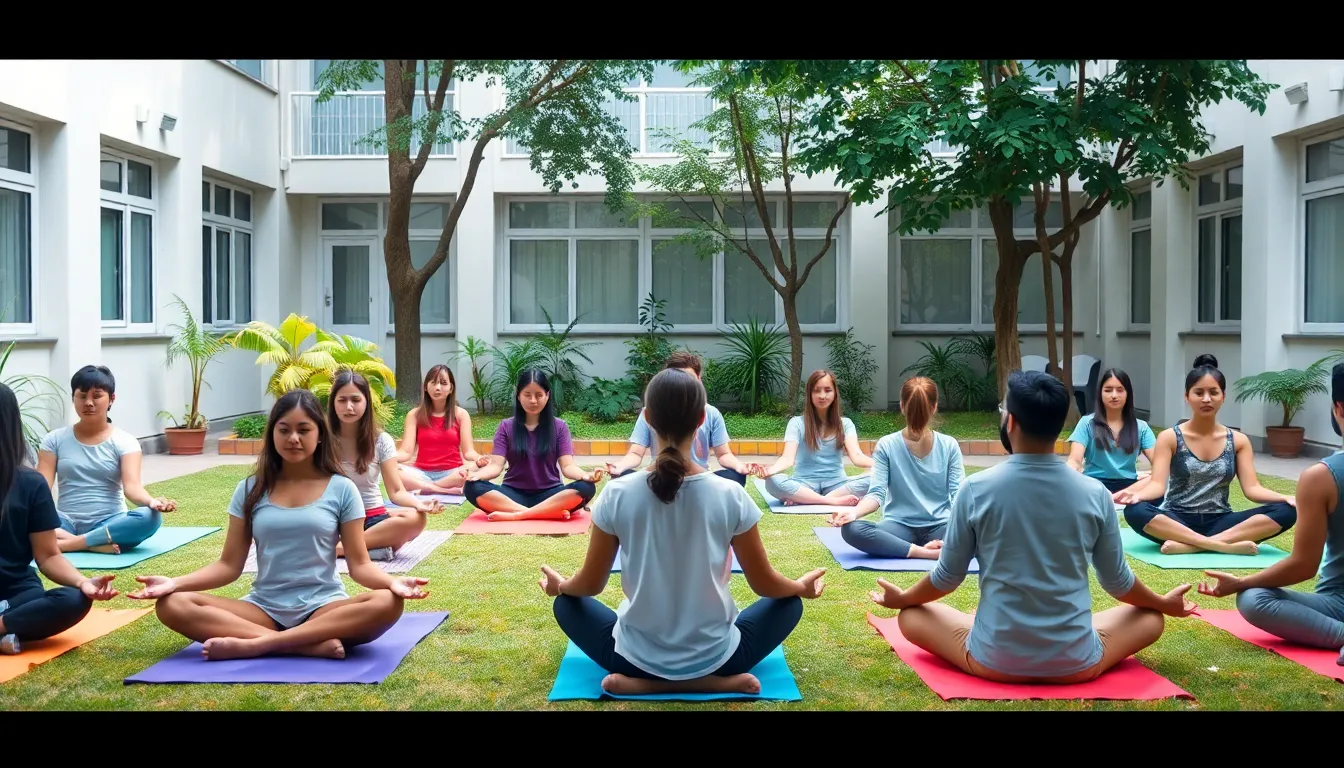In today’s fast-paced world, students juggle deadlines, exams, and social lives like circus performers on a tightrope. It’s no wonder they often feel overwhelmed. Enter mindfulness practices—students’ secret weapon against the chaos. Imagine transforming stress into calm with just a few minutes of focused breathing or a quick meditation session. Sounds like magic, right?
Mindfulness isn’t just for yogis in flowing pants; it’s a practical tool for anyone looking to boost focus and improve well-being. By incorporating simple techniques into their daily routine, students can enhance their concentration, reduce anxiety, and maybe even find that elusive peace of mind. So why not trade in a few minutes of scrolling through social media for some mindful moments? After all, a little zen can go a long way in acing those exams and enjoying the journey.
Table of Contents
ToggleOverview of Mindfulness Practices for Students
Mindfulness practices offer effective methods for students to manage stress and enhance well-being. Techniques focus on achieving present-moment awareness through simple exercises. Breathing exercises serve as a foundational practice. Students can benefit from deep, slow breaths to promote relaxation.
Meditation provides another powerful tool. Even a few minutes of guided meditation can help establish mental clarity. Finding a quiet space fosters concentration and aids in reducing anxiety. Engaging in mindfulness meditation can enhance focus and resilience.
Mindful movement integrates physical activity into mindfulness. Activities like yoga or tai chi encourage awareness of the body and breath. These practices not only improve flexibility but also foster mental calmness.
Journaling is an additional practice that encourages reflection. Writing about thoughts and feelings can help students process experiences. Journaling promotes emotional awareness and provides an outlet for stress.
Mindfulness apps and online resources offer accessible guidance. Many applications provide structured programs for various mindfulness practices. Students may find supportive communities online, enhancing their experience.
Setting aside time for these practices can significantly benefit students. Regular engagement in mindfulness can lead to improved academic performance. Adopting mindfulness techniques leads to greater emotional regulation and resilience in navigating school demands. Integrating these practices into daily life supports not only academic success but also overall well-being.
Benefits of Mindfulness in Education

Mindfulness practices offer numerous advantages for students navigating academic pressures. These techniques promote overall well-being and enhance learning outcomes.
Improved Focus and Concentration
Improved focus and concentration stem from consistent mindfulness practices. Students experience heightened awareness, making it easier to engage fully with their studies. For instance, mindful breathing exercises help clear distractions, allowing thoughts to flow more freely. Additionally, regular meditation cultivates a calm mind, which contributes to better retention of information. Over time, students report enhanced attention spans, leading to increased productivity and effective study habits. These simple practices equip students to tackle their academic challenges with clarity and intention.
Stress Reduction Techniques
Effective stress reduction techniques emerge from mindfulness practices. Rates of anxiety and stress decrease significantly when students incorporate mindful exercises into their daily routines. Simple breathing exercises or engaging in mindful movement, such as yoga, provide immediate relief during overwhelming moments. Journaling also serves as a valuable outlet for emotional expression, fostering self-reflection and awareness. By dedicating time to these practices, students build resilience against academic pressures while promoting emotional health. Incorporating mindfulness into educational settings can dramatically improve students’ ability to manage stress effectively.
Popular Mindfulness Practices for Students
These mindfulness practices offer students effective ways to manage stress and enhance their academic experience.
Meditation Techniques
Meditation serves as a practical method for promoting mental clarity. Guided meditation sessions help students focus their thoughts, making it easier to tackle assignments. Short sessions, ranging from five to ten minutes, can significantly improve concentration levels. Students may also explore techniques like mindfulness meditation, where they concentrate on the present moment, allowing distractions to fade away. Resources such as apps provide structured programs, making meditation accessible and easy to follow. Consistent practice leads to an increased ability to handle academic pressures.
Breathing Exercises
Breathing exercises provide students with quick stress relief. Deep breathing techniques, such as the 4-7-8 method, encourage slower, deeper breaths. This exercise involves inhaling for four counts, holding for seven counts, and exhaling for eight counts. Such practices activate the body’s relaxation response, reducing anxiety. Students can also try box breathing, which requires inhaling, holding, exhaling, and pausing for equal counts. Both techniques promote calmness and increase focus, making them ideal for busy students facing tight deadlines.
Mindful Movement Activities
Mindful movement activities blend physical exercise with focus on the present moment. Yoga stands out as a popular choice, enhancing flexibility while promoting relaxation. Through poses and stretches, students connect their body and mind, supporting emotional well-being. Tai chi offers another option, emphasizing slow movements and breathing coordination. This ancient practice helps reduce stress while improving balance and overall physical health. Engaging in mindful movement encourages greater awareness of bodily sensations, allowing students to relieve tension effectively.
Implementing Mindfulness in the Classroom
Incorporating mindfulness into educational settings enhances student well-being and supports learning. Effective strategies help educators facilitate these practices in a structured manner.
Strategies for Educators
Educators can introduce brief mindfulness exercises before classes, setting a positive tone. Start with deep breathing techniques, encouraging students to focus on their breath for a few minutes. Utilize guided meditations during transition periods to calm minds and improve focus. Designate time for reflective journaling after lessons, allowing students to process thoughts and emotions. Promote regular mindfulness check-ins, enabling students to express their feelings and support one another. Ultimately, these practices foster a culture of mindfulness, enhancing students’ academic experiences.
Creating a Mindfulness-Friendly Environment
Creating a mindfulness-friendly environment requires intentional space design and resources. Select quiet areas where students can practice mindfulness techniques without distractions. Incorporate calming visuals like plants or artwork to promote tranquility. Use soft lighting and comfortable seating, encouraging relaxation during mindfulness activities. Offer access to mindfulness apps and tools, providing structured guidance for students. Lastly, establish routines that incorporate mindfulness, making it a regular part of the classroom experience. This supportive environment enhances students’ ability to engage in mindfulness practices consistently, improving their overall well-being.
Integrating mindfulness practices into daily routines can significantly transform a student’s academic experience. By embracing techniques like focused breathing and meditation, students can cultivate a sense of calm that enhances their ability to concentrate and manage stress.
These practices not only support emotional well-being but also contribute to improved academic performance. As students navigate the challenges of their educational journeys, incorporating mindfulness can foster resilience and promote a healthier balance between study and personal life.
Ultimately, prioritizing mindfulness equips students with essential tools to thrive both academically and personally, paving the way for a more fulfilling educational experience.





